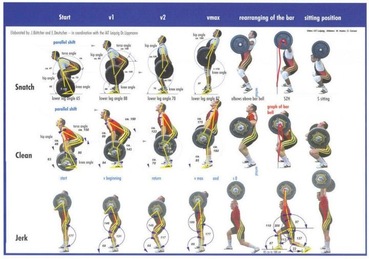
| 1. A General Warmup is light activity designed to get the heart rate elevated and the juices flowing through the body, as well as increase your work capacity a bit. We are trying to prepare ourselves with minimal fatigue. I like very simple exercises to warm the body, low skill, dummy proof, such as... - airdyne bike - 800 meter run - jumping jacks - jump rope - Concept 2 rower you'll notice Jim & Molly's general warmup is similar to my following section, joint mobility and light stretching. Thats cool, but I feel you will benefit more by doing a few minutes on a bike or something similar first. Its old school, but it works. | |
| 2. Joint mobility, light stretching, agility, activation Steve Cotter Mobility - please note that Steve is OUT OF HIS FUCKIN MIND Scott Sonnon Flow | |
| 3. Specific warmup - light variations of the actual work to be performed for the day - a great example for OLY lifters is the Burgener Warm Up - goblet squats, lunges, push ups, back extensions, shadow lifting are all good examples Jason C Brown BJJ Specific Warm Up Here is a good example of what NOT to do | |
- power lifting
- oly lifting
- strongman
- kettlebell sport
- CrossFit
- training that benefits your main objective
| 5. Secondary Work / Accessory / Assistance Lifts Access what the problem is in your training. Is it a technical issue or is it a strength issue? If its technical you will need to train it almost daily (high frequency) at sub maximal weights. If its strength you will need to train your weak areas to build them up. I like to use odd objects and variations of the main lifts to build weak areas. Brandon Lilly, author of the Cube Method, says, "After our main exercise we stop thinking like powerlifters, because as powerlifters we are trying to move maximum weights. On our assistance work we need to become bodybuilders. I don’t care to think I am going on a posing stage, but I am “building” my physique in such a way that maximizes my potential in powerlifting. I want to “look” like I lift weights. All of our assistance work will be 3-5 exercises after the main movement, and 3-4 sets per exercise. The goals for accessories: 1. Build Muscle and Attack Weak Body Parts 2. Create an Environment for Hypertrophy and Increase Fat Burning 3. Help Strengthen Muscles and Create Balance in Physique 4. Help to Prevent Injury 5. If a Movement Doesn’t Benefit “The Big 3” (or "Primary Work") Drop It
|
- Have fun here, but try not to smash the athletes to pieces and drastically cut in to the primary work. Remember, athletes need to be prepared for their sport, not be crushed in the gym. Keep the exercises simple in nature and do not mix skill with conditioning. High rep barbell snatches are not a wise idea as it will deteriorate technique and increase risk of injury. I usually do my conditioning at the end of a workout as a finisher for about 5-10 minutes. But if you're a fitness freak you can do it as a totally separate workout. You FREAK.
Options:
- CrossFit style met cons
- sleds/prowler/running
- carries
- battling ropes
- be fun and creative, but keep it simple and work hard while KEEPING THE GOAL IN MIND!
| 7. Heavy Stretching - Best performed after training, right before bed and upon waking after a little walk. Before training I only do enough stretching to help me get in to better positions for my lifts. - Heavy stretching will hurt and make you sore, but it will make you better. | |
 RSS Feed
RSS Feed